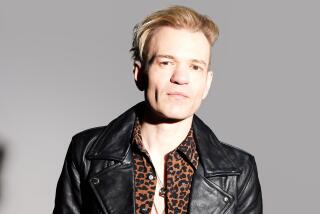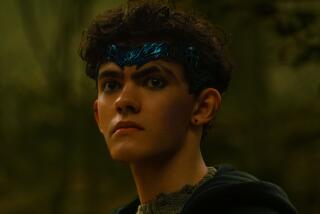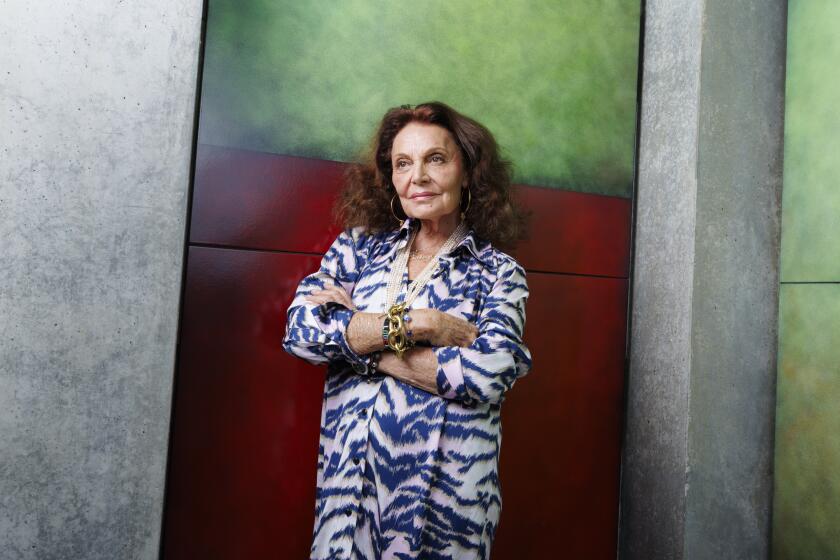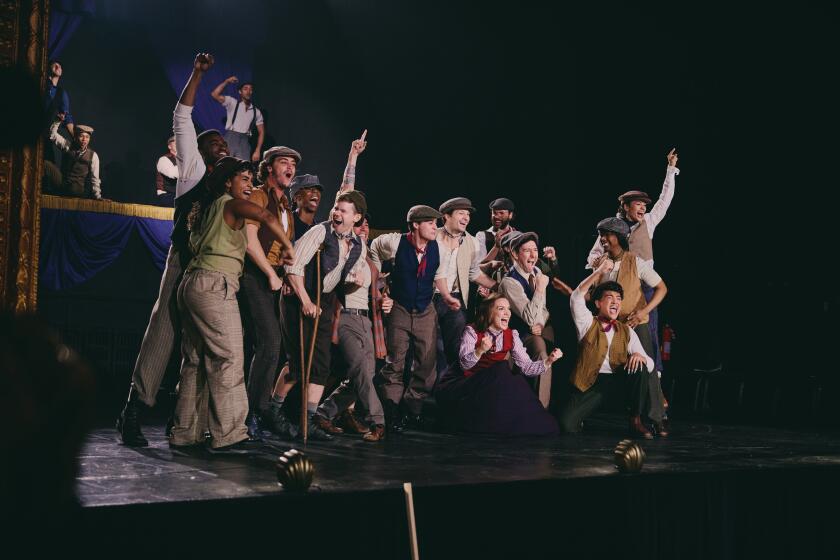Transformagic of Thomas Woodruff
Even the worst cliches usually have a grain of truth in them. The same goes for cliched imagery: Somewhere, buried within the numbing banality of such work, there is a genuine link between the objects and the emotions they evoke.
The peculiar genius of Thomas Woodruff--a New York painter whose elaborately conceived series of works are at the Huntington Beach Art Center--is his ability to resurrect debased imagery from sources as disparate as tattoos and Victorian mourning cards and use it to express intense states of emotion.
Bolstered by theatrical flair, a teeming imagination, a broad grasp of cultural history and enormous personal conviction, Woodruff’s kitsch imagery is oddly affecting yet happily resistant to pat categorization. An elegiac tone suffuses these exquisitely rendered paintings, in which Victorian flower garlands, dandified clowns and apples become talismans of grief and hope in the age of AIDS.
The earliest series in the show, “Rosabelle, Believe: Movement Impermanent” (from 1987, when Woodruff was 30), announces key elements of his style.
It is a series of “portraits” of a snowman, seen in settings that suggest different moods and historical painting styles, from homey genre art (a garland of lights at a lake) to the magisterial spiritualism of landscape painter Kaspar David Friedrich (looming snowy cliffs).
*
Intrinsically impermanent, the snowman becomes a wistful reminder of the youthful energies that created it. Adroit scene-setting invests a jolly generic image with pathos and the sort of romantic individualism associated with 19th century self-portraits.
The theme continues in Woodruff’s “Crying Clown” paintings, a group of self-portraits. They are part of his “Chromatic Aberration” series of 1990-91, which also includes images of human hearts pierced with bloody daggers and vignettes involving flowers and small animals.
Elaborately dressed in costumes evoking commedia dell’arte players, Elizabethan courtiers and figures from 19th century American genre paintings, Woodruff gazes at the viewer with the same blank expression in each painting, sometimes leaking a few tears. In a gorgeous display of the pathetic fallacy, tears hang like medals from his chest, hover in the air or transform themselves into glass stickpins or butterfly bodies.
Combining the emotional intensity historically associated with artists’ self-portraits with a heightened theatricality, Woodruff has remade the classic image of the secretly sorrowing clown. Beauty, pain, longing and the fleeting quality of life are the leitmotifs of this work. Despite major differences in style and approach, Woodruff seems distantly linked to Watteau, who evoked a lushly evanescent theatrical world, painted a famous clown image (“Gilles”) and who died at the tender age of 37.
Woodruff’s other big theme is the deep-seated belief in magic, the constellation of superstitions that offer their own peculiar brand of hope. The paintings are laced with the coded language of wish-fulfillment, the magic of signs and portents that permeates popular culture (Christian and pagan flower symbolism, phases of the moon, good-luck tattoos).
*
Adding quirky free association to the mix, Woodruff-the-alchemist turns cheesy “straw” into emotional “gold.” A great virtue of “Nosegays and Knuckle Sandwiches,” organized by the Atlanta College of Art Gallery, is its generous sampling of Woodruff’s work. Like a theatrical event, it requires total immersion in an elaborately staged imaginary universe.
In the hothouse atmosphere of Woodruff’s “Sweet and Sour Babies” series, vivid images of small children’s transparently emotional faces--flickering between glee and hurt--could be understood as windows to the soul.
Surrounding these faces are symmetrical groupings of unlikely objects: candy corn, sequined bats and chrysanthemums; sausage links, peacock feathers and irises. Looking somewhat like bizarre transformations of the seasonal decorations children make in school, these brilliantly colored images evoke a sensual universe of harmonious diversity--a primeval world of wonder.
“The Secret Charts” series from 1994 is Woodruff’s most baroque effort, a tumultuous Last Judgment or a magic show overrun by demonic forces.
The paintings teem with cartoon-like facial mutations, occult eye imagery, celestial scrolls, encrypted messages and the by-now familiar panoply of flowers and birds--all suspended over an ever-changing landscape. A catalog essay explains the series’ origin in the agonies of a friend dying of AIDS in a ward hung with Halloween decorations.
That series seems to have marked a watershed in Woodruff’s vision, freeing him last year to paint his most affecting work, “Apple Canon.” It consists of 365 individual “portraits” of apples--the edible amulet for daily health.
*
As the year progresses, several varieties of apples appear, presented with stepped-up special effects. They are carved with faces or numbers, cut up, peeled, skewered, flower-crowned, posed on white satin, invaded by rakish worms impersonating stereotypical figures from children’s rhymes.
The artist’s feverish search for novel ways to present the apples becomes a miniature parallel to the race to develop a cure for AIDS. A worm in doctor’s garb wriggles away from the last apple, covered with a spider’s web, suggesting yet another magical scenario: eternal life, with no need of medical intervention.
Woodruff’s own magical power is his ability to sneak under our skin with his strange bag of tricks, recharging stock imagery with a phantasmagorial new life.
* “Nosegays and Knuckle Sandwiches: Works by Thomas Woodruff,” through July 13, Huntington Beach Art Center, 538 Main St. Hours: Tuesday, Wednesday, noon-6 p.m.; Thursday-Saturday, noon-8 p.m.; Sunday, noon-4 p.m. Admission: $3 general, $2 students and seniors. (714) 374-1650.
More to Read
The biggest entertainment stories
Get our big stories about Hollywood, film, television, music, arts, culture and more right in your inbox as soon as they publish.
You may occasionally receive promotional content from the Los Angeles Times.










